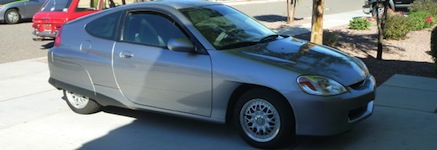
I actually enjoyed driving it.
I spend a lot of time on this blog talking about luxury cars, large SUVs, and almost anything over 4000lbs, but here I am extolling the virtues of a two-seater hybrid that rides like a roller skate and looks like a Tic Tac that was left in the microwave for too long.
Have I lost my mind? Possibly, or the maybe Insight managed to win me over.
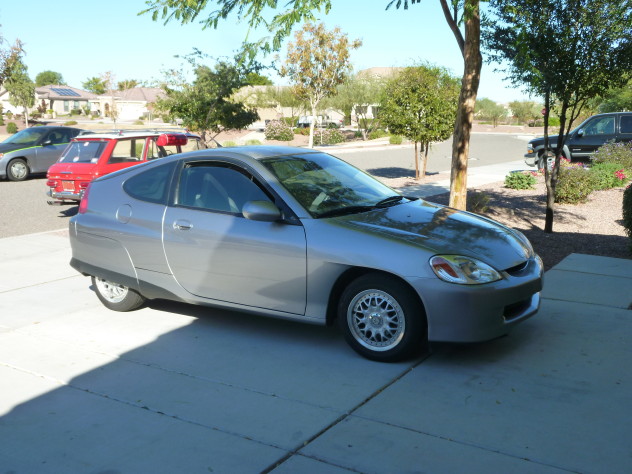
It looks like one of those experimental “cars from the future” that you saw on TV shows like Beyond 2000, like a prototype that would never see production.
Fast Tube by Casper
With its diminutive footprint and goofy fender skirts, I got the impression that the first-generation Insight was a project born out of a college engineering class rather than a well-established Japanese automaker. And with its obnoxiously cute radio antenna protruding from the roof, I was tempted to ask Greg where the controller was.
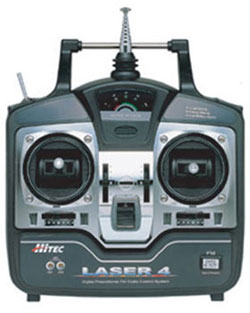
Instead, he handed me a proper set of keys. And thankfully, the Insight is a fully competent, thoughtfully designed car for normal human beings.
It’s hard to believe that something so small and so interesting could get past Honda’s conservative management. It’s even harder to believe that it was sold in the US while gas prices were at their lowest, hovering around 90 cents per gallon here in Missouri.
There’s a little bit of soul in the Insight that loosely reminds me of the legendary Honda CRX. It isn’t quite as sporty, light, or sharp, but it has some of the CRX’s free-wheeling, underdog eagerness. I found myself rooting for it as it quietly climbed to highway speeds.
Yes, it’s slow, taking 10-12 seconds to reach 60 mph, but that’s fine. There’s enough fun around corners to compensate for what it can’t do in a straight line. The light clutch and precise shifter somewhat reminded me of the world’s greatest modern roadster: the Mazda Miata.
For reference, the Insight’s acceleration is on par with most minivans that were on the road at the turn of the century. You get enough oomph to drive safely and deal with normal traffic, but the only thing you’ll beat in a drag race is a dead donkey.
Speed is less relevant when you’re having this much fun flinging it around city blocks and roundabouts, all while paying next to nothing for fuel.

So, up yours, OPEC.
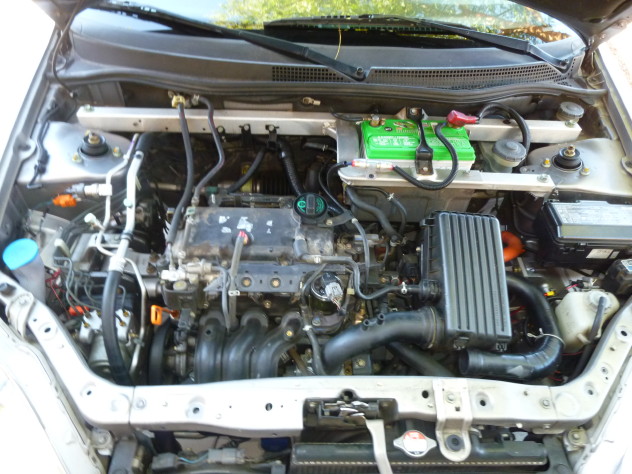
Under the hood, it looks like your average Honda. There’s a tiny 3-cylinder engine, a small electric motor, and standard accessories. Here in southern Arizona, air conditioning is a necessary option.

The digital gauges go well with the Insight’s futuristic styling, with little light bars that fill in the increments where a needle would be and a large digital speedometer that looks like it was plucked from a Formula 1 race car. The “CHRG-ASST” indicator tells you when you’re recharging (with regenerative braking) and when you’re draining the battery for power.
Greenophiles might take this as a challenge to drive more efficiently. I simply ignored it and hammered the throttle.
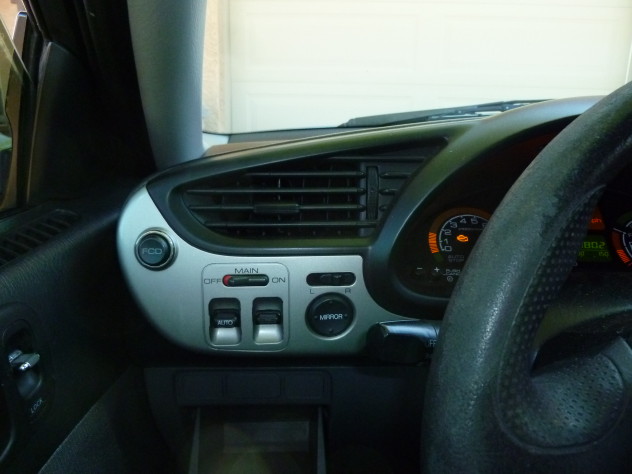
The rest of the interior is standard Honda. There’s power accessories galore, solid switchgear, and respectable ergonomics.
That button out on the left that says “FCD” is for the Fuel Consumption Display. It shows instant and average fuel economy. In the FCD segment display mode, a digital gauge graphically displays your current consumption level. Remember the “ECO” needle in older German cars that went down to zero as you floored the gas pedal? It’s kind of like that.
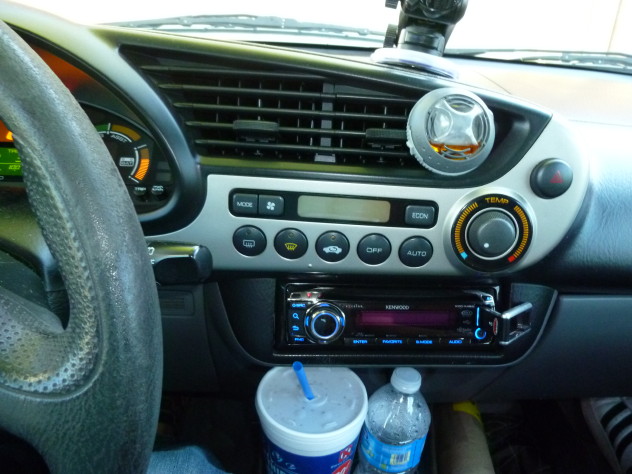
Automatic climate controls are a nice bonus, completely unexpected in an economy car. While it’s well optioned with auto AC, power mirrors, power door locks, and power windows, the interior itself is full of hard plastics. That’s all pretty forgivable considering the low cost of entry — this was never meant to be an Acura.
Fortunately, the silver control panel spruces up the cockpit and the precisely fitted panels make up for a lack of surface softness. After ten years of motoring, this Insight was free of rattles or irregularities, another example of Honda’s traditionally outstanding build quality.
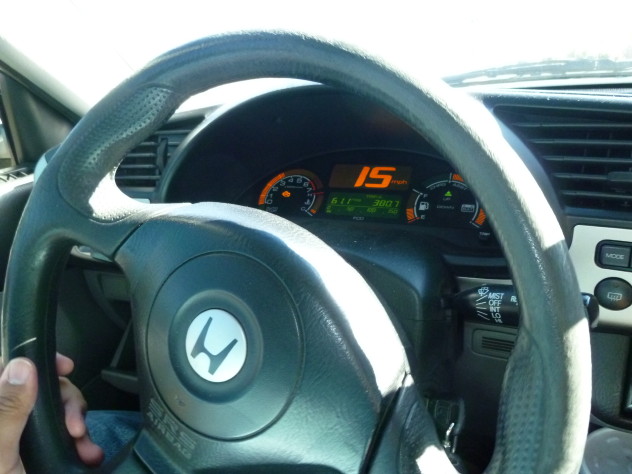
This is what came to mind as I rowed through the gears:
Fast Tube by Casper
The gearing, by the way, is tall, intended for fuel economy rather than stoplight races. It reminded me of my dad’s old 1992 Honda Civic VX, another one of Honda’s sharp-handling feather-light fuel sippers. (You can read the review here.)
The Phoenix area, aside from some protruding mountains and other bits of scenery, is primarily a flat desert. This little Insight won’t be subjected to hill climbs unless you take it up to Flagstaff. With myself (220lbs) and my friend (280lbs) weighing down the diminutive little car, it didn’t seem to struggle. That’s likely due to the additional torque provided by the electric motor or as Honda likes to call it, “Integrated Motor Assist.”
Once we got moving, it was easy as long as momentum was maintained. Steering was disconcertingly light for my tastes and it seemed out of place with the Insight’s sporty handling, light clutch, and crisp shifts.
Road trips aren’t exactly a strong point with the short wheelbase, road noise, and bumpy ride, but the Insight excels at local and regional commuting, the kinds of miles you don’t enjoy anyway as you idle in rush hour traffic. Save your gas money and use it to top off your Corvette for the weekend — you can have your cake and eat it too.
It’s impossible to mention the Insight without bringing up it’s main competitor, the Toyota Prius.
I’ll admit, Toyota’s depressing little shitbox is bigger, more practical, and much softer over rough pavement, but it lacks the Honda’s handling prowess and outward charm, and it’s at least 20mpg short of the fuel economy you can achieve in the real world with an Insight, which is just under 70mpg. Where the Insight manages to be fun and quirky, the Prius comes off as dull and crude.
If you want to know what it’s like to spend hours in a Prius, ask my friend Gary who was forced to endure one for 200 miles. It’s a god-awful car for god-awful people who would be better off with bus passes. If you own one of these hideous lumps of misery, set it on fire and throw yourself in it.
There’s a belief among us, the automotive collective, the gas-guzzling, wrench-turning, freedom-loving enthusiasts, that the future is one of bleakness, one where the government chokes the joy out of motoring and we’re all forced to take public transportation where the poor and diseased cough and spit on our faces.
I worry too, but the Insight is a glimmer of hope, a shimmer of light that maybe this eco-friendly thing can actually be enjoyable. Subtract weight, add fun.
Let me summarize, in case you’ve skipped over the last few paragraphs: the Honda Insight is fun.
I should mention that the batteries in these cars don’t last forever. Forget about those scare stories warning of $8000 replacement costs. A company called Hybrid ReVolt in Greg’s backyard of Surprise, Arizona did the replacement of all cells for just over $1000. So, at $5000 for the car plus $1000 for the batteries you’re set for another decade of 60mpg, 600-mile-per-tank bliss.
Up yours, OPEC.
————————————
Original MSRP: $19,295 ($1200 for air conditioning)
Powertrain:
1.0L 12-valve 3-cylinder engine (weighs only 124lbs), 67hp / 66lb-ft
Permanent-magnet electric motor
144-volt nickel metal hydride battery array under the rear cargo area
Total output: 73hp / 91 lb-ft
5-speed manual transmission (CVT automatic arrived in 2001)
Braking:
Front disc/rear drum ABS brakes
Economy:
Idle stop mode (transmission in neutral, clutch out, AC off)
Regenerative braking
EPA: 61/70 mpg
Real world fuel economy: 40-65mpg depending on conditions and driving style
Performance:
0-60 acceleration: 11 seconds
Front strut/rear twist beam suspension
Structure and Dimensions:
Aluminum chassis and frame
1850lb curb weight
5 cubic feet rear cargo space (plus 1.5 cubic foot hidden compartment)
Jesda, your description of the Prius nailed the way I feel about that POS. Also, all the Prius owners I know are Smug, self-righteous shits.